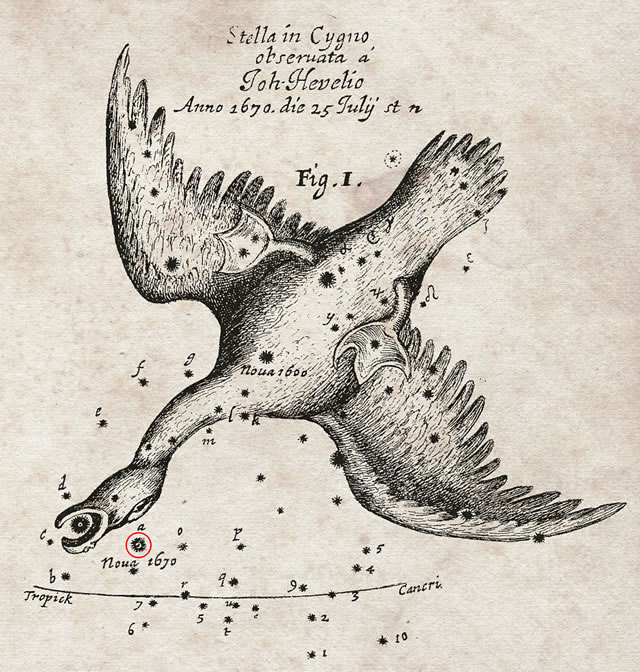
Le osservazioni con APEX contribuiscono a risolvere il mistero di Nova Vulpeculae 1670 – Nuove osservazioni con APEX e altri telescopi rivelano che la stella vista comparire in cielo dagli astronomi europei nel 1670 non era una nova, ma un tipo più raro e violento di collisione stellare. È stato così spettacolare da essere visibile facilmente a occhio nudo durante il primo scoppio, ma le tracce lasciate erano così deboli che era necessaria un’analisi accurata con telescopi nella banda submillimetrica per poter risolvere l’enigma, svelato finalmente più di 340 anni dopo. I risultati appaiono online sulla rivista Nature il 23 marzo 2015.
Alcuni dei più grandi astronomi del diciassettesimo secolo, tra cui Hevelius – il padre della cartografia lunare – e Cassini, hanno documentato accuratamente l’apparizione in cielo di una nuova stella nel 1670. Hevelius la descrisse come “nova sub capite Cygni” – una stella nuova sotto il capo del Cigno – ma gli astronomi ora la chiamano Nova Vulpeculae 1670. Resoconti storici di nove sono rari e di grande interesse per gli astronomi moderni. Nova Vul 1670 è ritenuta sia la più vecchia che la più debole delle nove che si ricordino. L’autore principale di questo lavoro, Tomasz Kamiński (ESO e Max Planck Institute per la RadioAstronomia, Bonn, Germania), spiega: “Per molti anni si è pensato che questo oggetto fosse una nova, ma più lo si studiava e meno sembrava una nova normale – o comunque un qualsiasi tipo di stella esplosa”. Quando è apparsa per la prima volta, Nova Vul 1670 era facilmente visibile a occhio nudo e ha variato la sua luminosità nel corso di due anni, dopo di che è scomparsa e riapparsa per ben due volte prima di sparire del tutto. Anche se ben documentata per l’epoca, agli astronomi mancavano gli equipaggiamenti necessari per risolvere il quesito della comportamento peculiare della presunta nova. Nel corso del ventesimo secolo, gli astronomi impararono che la maggior parte delle novae potevano essere spiegate dal comportamento esplosivo instabile di binarie strette. Ma Nova Vul 1670 non aderiva a questo modello e rimase perciò un enigma.
Colliding Stars Explain Enigmatic Seventeenth Century Explosion – APEX observations help unravel mystery of Nova Vulpeculae 1670 – New observations made with APEX and other telescopes reveal that the star that European astronomers saw appear in the sky in 1670 was not a nova, but a much rarer, violent breed of stellar collision. It was spectacular enough to be easily seen with the naked eye during its first outburst, but the traces it left were so faint that very careful analysis using submillimetre telescopes was needed before the mystery could finally be unravelled more than 340 years later. The results appear online in the journal Nature on 23 March 2015.
Some of seventeenth century’s greatest astronomers, including Hevelius — the father of lunar cartography — and Cassini, carefully documented the appearance of a new star in the skies in 1670. Hevelius described it as nova sub capite Cygni — a new star below the head of the Swan — but astronomers now know it by the name Nova Vulpeculae 1670 [1]. Historical accounts of novae are rare and of great interest to modern astronomers. Nova Vul 1670 is claimed to be both the oldest recorded nova and the faintest nova when later recovered. The lead author of the new study, Tomasz Kamiński (ESO and the Max Planck Institute for Radio Astronomy, Bonn, Germany) explains: “For many years this object was thought to be a nova, but the more it was studied the less it looked like an ordinary nova — or indeed any other kind of exploding star.” When it first appeared, Nova Vul 1670 was easily visible with the naked eye and varied in brightness over the course of two years. It then disappeared and reappeared twice before vanishing for good. Although well documented for its time, the intrepid astronomers of the day lacked the equipment needed to solve the riddle of the apparent nova’s peculiar performance. During the twentieth century, astronomers came to understand that most novae could be explained by the runaway explosive behaviour of close binary stars. But Nova Vul 1670 did not fit this model well at all and remained a mystery.
Source/Continue reading → ESO.org
Leggi anche/Read also: DENEB Alpha Cygni – Costellazione del Cigno – Cygnus Constellation





















